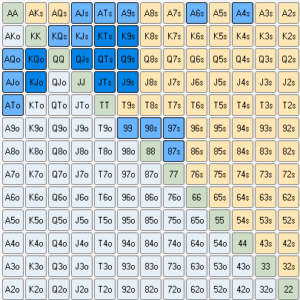How to Calculate Pot Odds
Learning how to calculate pot odds is essential to understanding the underlying mathematics of Poker.
There’s no denying that poker is a game of feel and intuition. It’s a game of reading your opponents, and changing your game to exploit them.
However, the vast majority of your options in poker are fundamentally wrong or right based on odds.
In a nutshell, pot odds tell you how often you need to succeed with a given play (given the size of the pot and the bet) in order for that play to be profitable.
How to Calculate Pot Odds with a Draw
Let’s start with an example. You hold:
On a board of:
Your opponent bets 2/3rds pot for 10$ into a 15$ pot. What do you do?
You have 8 cards in the deck that give you the nuts: Four 5s, and four Ts. Against a hand like AK, you have 34% equity.
You have to call 10$ in total, to win $25 from a total pot of $35. Your odds are 2.5:1. In other terms, when you call, the total pot will be 10$ (his bet) + 10$ (your call) + 15$ (the money in the pot already) or 35$.
Your equity share of the pot MUST be greater than your dollar share (10/35 = 28.5%) for this call to be profitable assuming:
- No more money goes into the pot
- You never win by bluffing
- You never win at showdown unless you make your straight.
Here, you have 34% in equity with a 28.5% dollar share in the pot. You hit the call button since your equity > dollar share.
How to calculate pot odds with a bluffcatcher
Here’s a different scenario. You hold:

On a board of:
The action went like this: your opponent opened the SB to 3x, you 3bet to 9x, and he called. You checked back the flop, and he bet 11$ into a pot of 18$ on the turn. You called.
On the river the pot is now $40, and he bets $22 into you. Should you call?
You estimate he is an aggressive player who would have bet all straight draws, flush draws and backdoor flush draws on the turn. He would continue to bluff with those hands after missing on the river.
You think he’s betting any strong top pair, any two pair, the occasional 78s, and 99 for value.
You decide that his range looks something like this (dark blue hands are heart-x combos, light blue are all combos).
With your JhJc, you have 37% equity against this range. You need 20/(20+20+40) or 25% equity to call. In other words, you need to win 1 in 4 times, however you are winning greater than 1 in 3 times.
So. 37% of the time you win the $40 in the pot + his $22 bet ($62). 63% of the time you lose your $22 call.
EV = .37 * $62 – .63 * $22 = +$9.08
The difference between your pot odds and your equity generates a hugely profitable spot for you. Over the long run, you profit $9 every time you find yourself in this spot, even though you win less than half the time!
You hit the call button and laugh regardless of whether you win (37% of the time) or lose (63% of the time), knowing that in the long run you are making a big profit with this call.
Conclusion
You can make decisions on whether or not certain plays are profitable with a good understanding of pot odds.
By using simple math, you can determine your drawing odds, bluffcatching odds and necessary equity for a call.



























